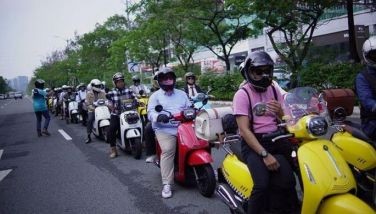Nail ’em, Spike!
March 13, 2002 | 12:00am
 Ogie Alcantara knows a good motorcycle when he sees one. The former motocross king of Iloilo, now temporarily retired from competition due to injuries, would tell you straight when a bike is not worth riding, much less buying.
Ogie Alcantara knows a good motorcycle when he sees one. The former motocross king of Iloilo, now temporarily retired from competition due to injuries, would tell you straight when a bike is not worth riding, much less buying.
So we asked his opinion first before we tried out Kymco’s newest moped, the Spike. "Is it better than the... ?" we asked, deliberately deleting the name of a competitor’s product. "Malayo," was his quick remark. "No comparison."
You see, Ogie now rides a Spike daily. Being the quality control inspector at Kymco’s assembly plant in Parañaque, he was given an orange Spike as a service vehicle. Used to powerful enduros, he swears that the Spike’s strength is just a little less if not equal to that of small off-roaders. But what sets the Spike apart from big 125s, according to him, is its size and weight. "Watch me," he says before taking off and doing a wheelie. "It’s a bike that is very easy to use."
Ogie’s positive impressions on the Spike was shared by many who have seen the bike during its launched in Dumaguete City last month. Manuel Sta. Cruz, Kymco Pilipinas president, said the people of Dumaguete are the most experienced when it comes to evaluating mopeds.
"Dumaguete is the moped-riding capital of the country," he says. "That’s why we launched the Spike there. We wanted to know what the Dumaguete residents would feel about the new bike."
Sta. Cruz initially had doubts on the Spike’s chances in the market. For one, the bike didn’t have the typical moped look. Except for its big tires, the Spike’s design is closer to that of scooters.
"I was really shocked," he said. "After the launch, we immediately got some 300 orders. We were just hoping at best for a sale of 400 units for our first month but we sold a total of 600. Now I know we have a winner of a product in our hands."
Gilbert Limjoco, Kymco Pilipinas vice president for operations, said their mother company developed the Spike specifically for the Philippine market. "We are the only country in Asia where Kymco does not have a moped," he said. "So our bosses in Taiwan thought of developing something unique, something with features that are more advanced than those being offered by our competitors."
Kymco’s designers started off from scratch in building the Spike. They gave it an entirely new contour (the tailpipes are slanted upward), put the best engine they could find (the biggest in mopeds at 125cc), installed a single rear suspension (just like those in enduros), and attached various bonus features such as a brighter halogen lamp, a very user-friendly instrument panel, a front disc brake, a tailpipe heat shield, and removable leg shield.
They didn’t stop there. They also made sure the Spike would have a storage compartment and would be available in different colors such as red, blue silver and – the most-sought-after of them all – orange.
"No one in the company ever guessed that buyers would prefer an orange moped," Sta. Cruz said. "So you can imagine our surprise when we ran out of stocks the first month. Ang daming may gusto nung orange."
Kymco Pilipinas assembles the Spike as well as its more than a dozen other motorcycle models in its own plant which also serves as the national warehouse for Kymco spare parts. The youngest and the only non-Japanese member of the exclusive Motorcycle Development Program Participants Association, it hopes to offer better motorcycles at lower prices.
"Kymco used to be the Honda Taiwan," boasts Limjoco, himself a former Honda Philippines official. "That’s why buyers are assured that our products are at par, if not better, with the best."
The Spike, we were told, is now being retailed at less than P55,000. Well, that was one thing Ogie wasn’t sure about so better inquire yourself.
BrandSpace Articles
<
>
- Latest
Latest
Latest
September 30, 2024 - 4:26pm
By EC Toledo | September 30, 2024 - 4:26pm
September 26, 2024 - 3:30pm
September 26, 2024 - 3:30pm
August 16, 2024 - 11:00am
By Euden Valdez | August 16, 2024 - 11:00am
Recommended




























